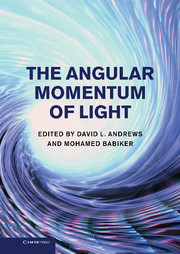Book contents
- Frontmatter
- Contents
- List of contributors
- Preface
- 1 Light beams carrying orbital angular momentum
- 2 Vortex transformations and vortex dynamics in optical fields
- 3 Vector beams in free space
- 4 Optical beams with orbital angular momentum in nonlinear media
- 5 Ray optics, wave optics and quantum mechanics
- 6 Quantum formulation of angle and orbital angular momentum
- 7 Dynamical rotational frequency shift
- 8 Spin-orbit interactions of light in isotropic media
- 9 Quantum electrodynamics, angular momentum and chirality
- 10 Trapping of charged particles by Bessel beams
- 11 Theory of atoms in twisted light
- 12 An experimentalist's introduction to orbital angular momentum for quantum optics
- 13 Measurement of light's orbital angular momentum
- 14 Efficient generation of optical twisters using helico-conical beams
- 15 Self-similar modes of coherent diffusion with orbital angular momentum
- 16 Quantum entanglement of orbital angular momentum
- Index
- References
16 - Quantum entanglement of orbital angular momentum
Published online by Cambridge University Press: 05 December 2012
- Frontmatter
- Contents
- List of contributors
- Preface
- 1 Light beams carrying orbital angular momentum
- 2 Vortex transformations and vortex dynamics in optical fields
- 3 Vector beams in free space
- 4 Optical beams with orbital angular momentum in nonlinear media
- 5 Ray optics, wave optics and quantum mechanics
- 6 Quantum formulation of angle and orbital angular momentum
- 7 Dynamical rotational frequency shift
- 8 Spin-orbit interactions of light in isotropic media
- 9 Quantum electrodynamics, angular momentum and chirality
- 10 Trapping of charged particles by Bessel beams
- 11 Theory of atoms in twisted light
- 12 An experimentalist's introduction to orbital angular momentum for quantum optics
- 13 Measurement of light's orbital angular momentum
- 14 Efficient generation of optical twisters using helico-conical beams
- 15 Self-similar modes of coherent diffusion with orbital angular momentum
- 16 Quantum entanglement of orbital angular momentum
- Index
- References
Summary
Introduction
In this chapter, we will be concerned with entangled states of light. Historically, quantum states of light, i.e., photons, have played a dominant role in the experimental study of quantum entanglement. For instance, the first Bell tests and the first realizations of quantum teleportation were performed using two-dimensional polarization-entangled twophoton states [3]. From an experimental point of view these states are readily prepared and manipulated using conventional polarization optics.
Recently, however, both theoretical and experimental efforts have shifted towards entanglement in more than two modes, which is often referred to as high-dimensional entanglement. This is much richer than two-dimensional entanglement, as is, for instance, reflected in stronger violations of various measures of nonlocality which reveal the complexity of high-dimensional Hilbert spaces [4–7]. Also, from an applications perspective, it promises a larger channel capacity [8, 9] and improved security for quantum communication [10, 11].
There are several ways to implement high-dimensional two-photon entanglement. One can exploit the temporal [12], frequency [13], or spatial [14–18] degrees of freedom of the optical field. A promising way to implement high-dimensional two-photon entanglement is to use the orbital-angular-momentum (OAM) degree of freedom of light. Light beams that carry OAM have a helical wavefront that spirals around the optical axis during propagation [19]. The winding number m, which characterizes the OAM eigenmodes, can adopt any integer value between −∞ and ∞; since all coaxial OAM modes are orthogonal they can thus span a very high-dimensional Hilbert space.
- Type
- Chapter
- Information
- The Angular Momentum of Light , pp. 385 - 406Publisher: Cambridge University PressPrint publication year: 2012
References
- 1
- Cited by

